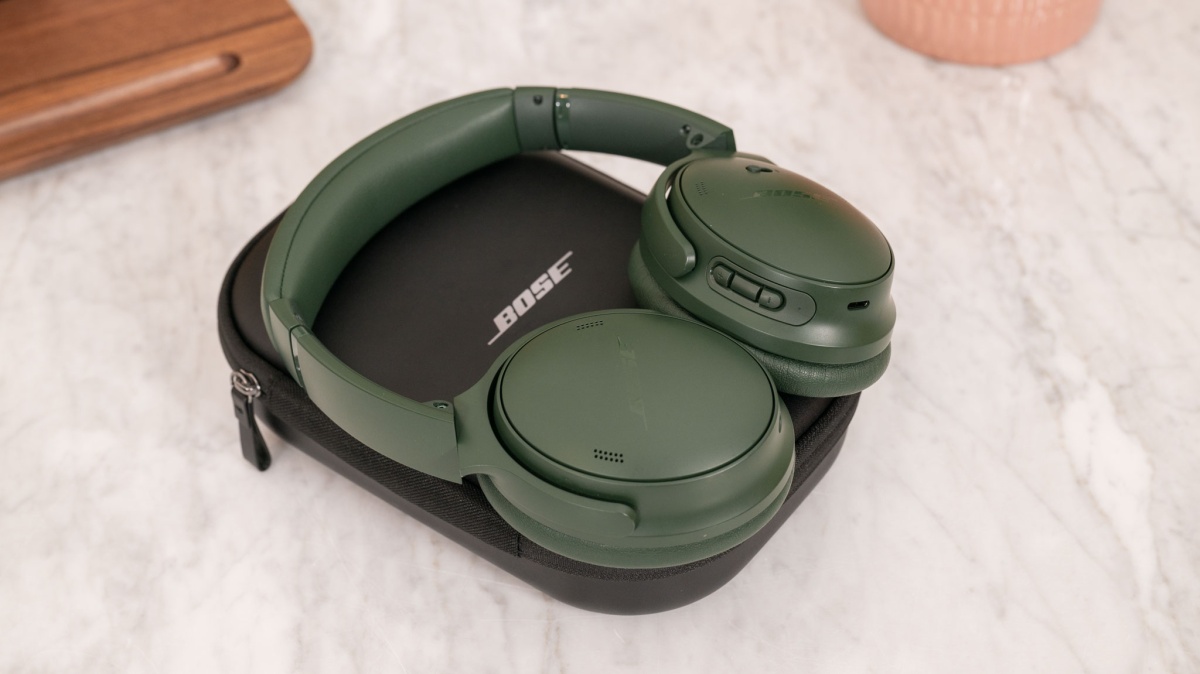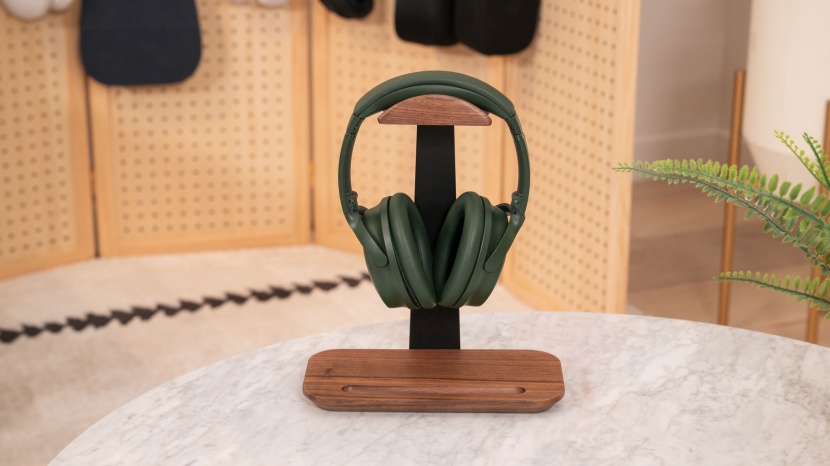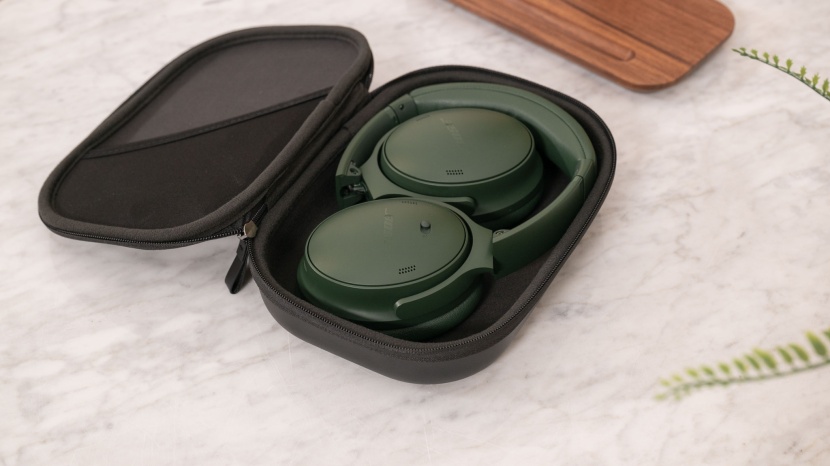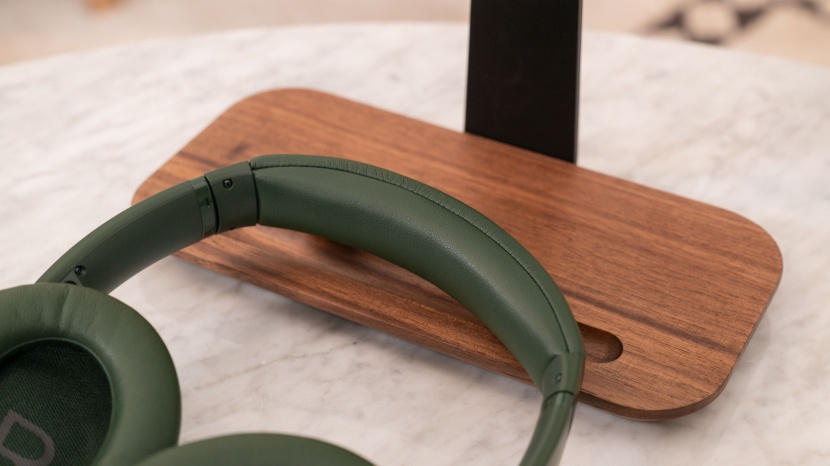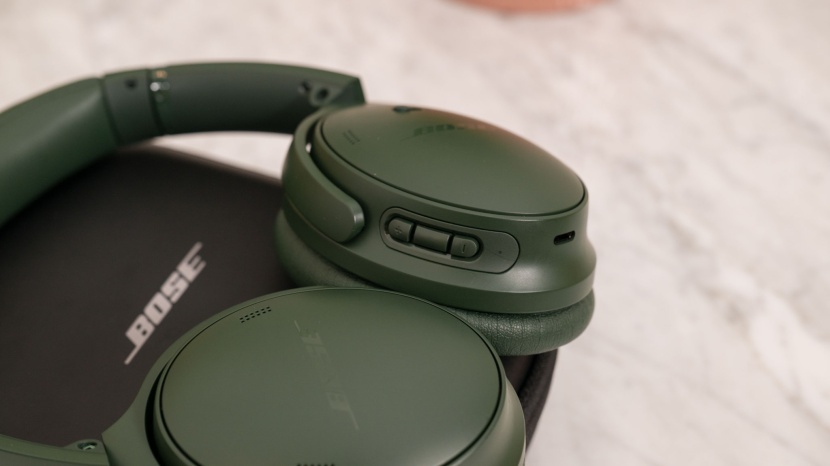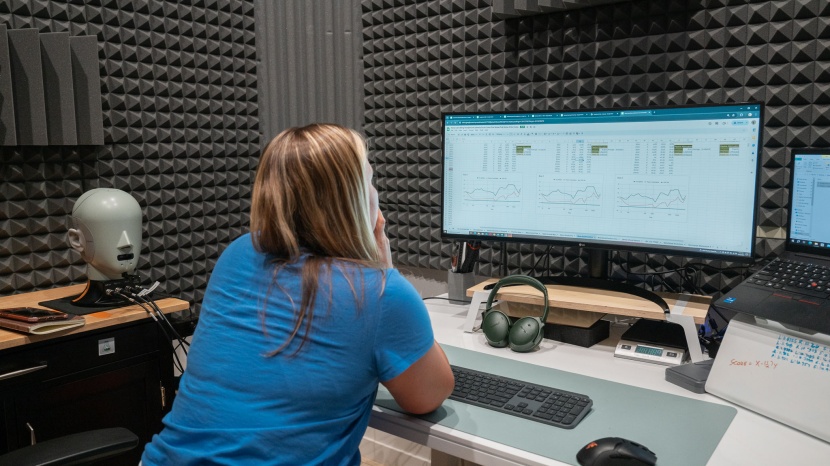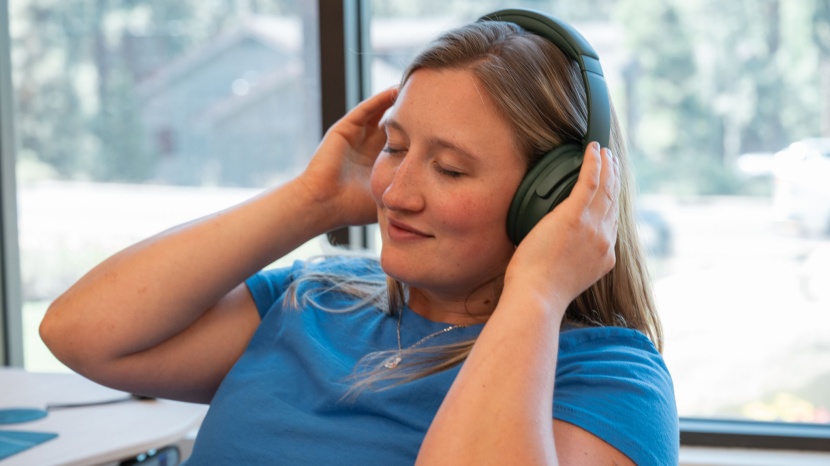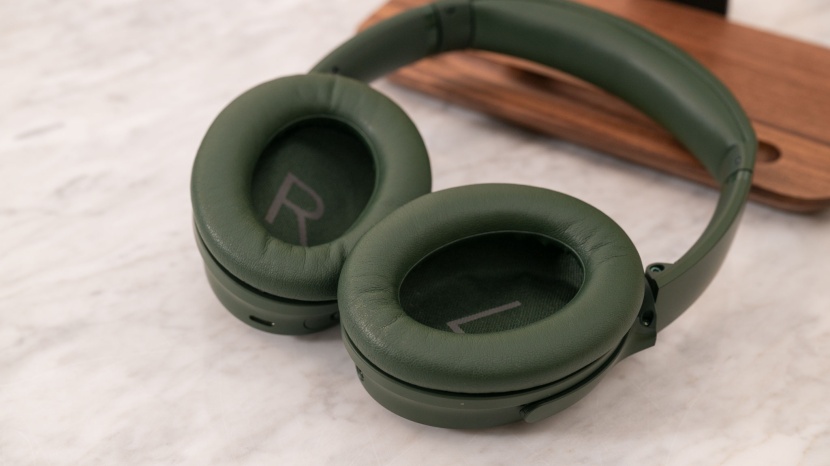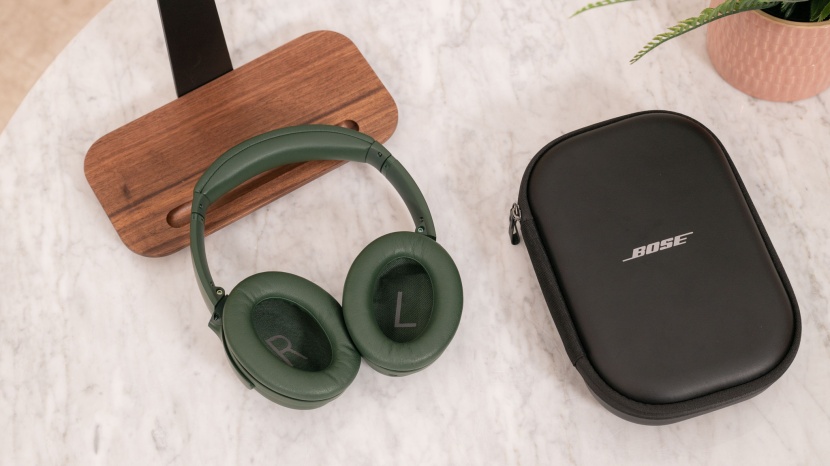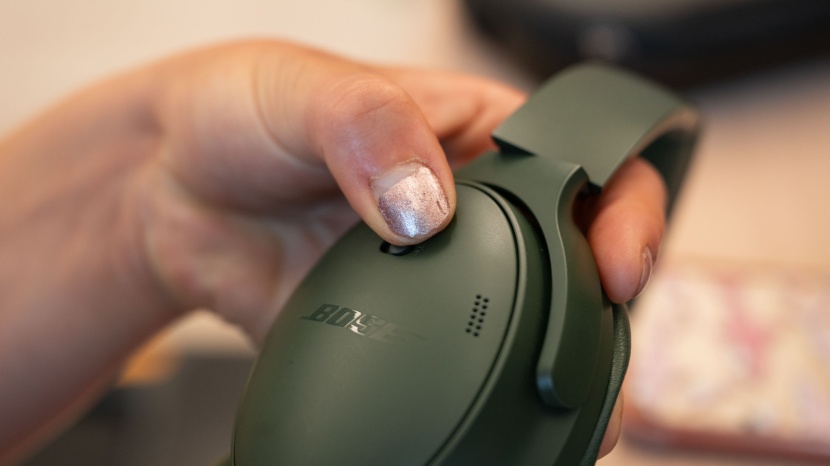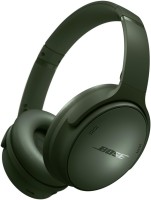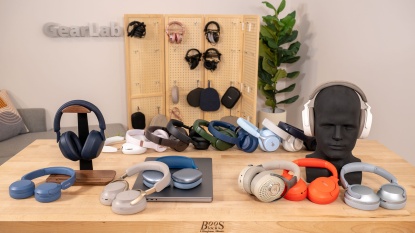
Our Verdict
Our Analysis and Test Results
Our Bose QuietComfort Headphones Experience
The Bose feels like a quality item right out of the box. While they lack better details like a fully padded headband, as seen in the more expensive Bose, they still feel solid, durable, and of higher quality than many competitors. They come with a case and a USB-A to USB-C charging cord, and 3.5 mm to 2.5 mm audio cable.
The QuietComfort features a rock-solid Multipoint connection, making it a dream to pair. The Bluetooth slider makes pairing easy. It seamlessly connects to new devices running any operating system and swaps audio without fault. Managing the connected devices in the Bose app is straightforward, and removing devices is easy.
The user experience, on the whole, is outstanding. These headphones feature intuitive controls and a well-designed app that enables customization. The cherry on top is a reliable connection to multiple devices on any operating system.
The QuietComfort are more comfortable than most. They have a gentle clamping force that feels secure but not tight, making these an excellent option for glasses wearers. We found that the cozy feel was maintained even with thick-framed specs, making them ideal for those who wear glasses. However, the fit is not good enough for activities beyond walking, and they easily fell off when we stretched back or made swift head movements.
While the battery life is expected to be sufficient at around 23 hours, it wasn't long enough for transcontinental travel or for those of us who forget to charge daily. After a long commute and work day, we forgot to charge them and ended up losing power the following day on the way home.
The QuietComfort isn't the one if you're looking for headphones to make calls. Voices sound like they are calling from a tunnel, and there is some buzz-sounding distortion at the beginning and ends of words. The distortion was so strong we couldn't distinguish between the words “doll” and “dogs.”
Sound Quality
Overall, we quite liked them! They have proficient gain (volume) and a solid, good, reliable sound quality. However, they don't provide that top-shelf, totally immersive sound experience that we were hoping for, but they still do a damn good job.
The sound on the QuietComfort is warm and fleshed out with great depth and body. We enjoyed listening to most genres of music, but the sound profile feels heavily sculpted. It's like listening to the cinematic version rather than sitting in the studio.
These headphones are perfect for anyone fond of punchy bass lines, with extra emphasis. The lows never sound muddied, even at loud volumes. We loved the added drama on hip-hop bangers like “IV. Sweatpants” by Childish Gamino and “Area Codes” by Ludacris. Taylor Swift's “Who's Afraid of Little Old Me?” was a delight.
These headphones shine in the mids, sounding natural with good clarity and clean precision. Instruments and vocals sound developed, but sometimes, the thumpy lows can overpower acoustic-style tracks, as we noticed while listening to indie, folk, and soft rock tracks from Father John Mistry and Jim Croce.
The highs sound crisp and present, but if we're nitpicking, they aren't entirely balanced with the other frequencies. They never sound harsh or tinny; we wish they were emphasized to add more sparkle or presence to singer-songwriter mixes, which often feature minimal instrumentation and a heavy emphasis on intimate vocals.
The frequency response analysis conducted in our cutting-edge audio studio complements the opinions of our panel of experts. The QuietComfort follows our Target Response well, with a marked deviation in the bass range. This indicates that the general blend of sound will complement most musical genres, but offer the best experience for punchy bass across hip-hop, pop, and dance genres.
The highs are also slightly elevated above our target response, and while we did notice some occasional sibilance, it was never piercing or keening. One of our testers said she could listen to music loudly and “never have to wince and reach for the volume button because of upper-end noises becoming too sharp.”
Soundstage
The QuietComfort headphones are almost spot on average in terms of soundstage.
You can definitely locate where each sound is supposed to be coming from on tracks like “Sunday Morning” by The Velvet Underground or “Where Do We Go from Here” by Charles Bradley. However, the sound doesn't feel as immersive as other models.
Comfort and Fit
The QuietComfort is one of the coziest pairs of headphones. We could all wear them for up to 10 hours straight without discomfort.
The plush faux leather on the earcups and headband is pleasant and buttery soft. The earcups can handle ears of nearly every size, with a measured interior size of 61 x 40 millimeters. Our testers, with ear dimensions ranging from 2.1 to 2.5 inches in height and 1.5 to 2.0 inches in width, found the fit to be perfect.
Noise Cancellation
The QuietComfort provides great, but not mind-blowing, active noise cancellation (ANC). It outperforms most budget-tier headphones we tested, but still falls short of some premium models.
The QuietComfort's microphones, located inside and outside the earcups, work together to limit external sounds by an average of 27 decibels. This was sufficient to block noisy distractions while riding in a car, running errands, or working in the office, but not strong enough to fully remove low-frequency, loud airplane humming.
Bose doesn't offer a true passive mode (sound-blocking based on physical design without the aid of microphones and algorithms). The two default settings are Quiet mode, where ANC is on, or Aware mode, where ANC is off, and external sounds are actively relayed through the headphones. The Aware mode is what a good transparency mode means, with a pleasant sound that is not overly loud, though not quite clear enough to carry on a conversation. To get a passive-ish mode, where ANC and transparency are off, you must create a custom ANC mode in the app.
The QuietComfort's ANC blocks out 20-30 decibels of sound in the mid-to-low range. The lack of passive mode isn't a deal breaker. However, if you experience headaches, dizziness, or disorientation with ANC and hope for a comfortable yet effective level, this pair might not work well for you.
App and Controls
We love the Bose app for ease of use and versatility. EQ customization is the most essential feature, allowing some to dial down the bass.
The presets have only four options that increase or decrease the gains of the bass or treble. The manual slider gives control over the mids, but we only noticed a difference if we really cranked the ranges up or down.
While technically the sound mix is customizable, it isn't the most fun. Unlike premium competitors that support spatial audio, the QuietComfort lacks this feature, missing out on the added layer of sound dimension.
Controls
The all-button controls earned top ratings for their reliability and ease of use. Unlike most headsets, which require you to depress the power button for 3-10 seconds to enter Bluetooth pairing mode, the Bose has a slide power button you hold in place until the indicator light blinks blue.
The QuietComfort also features multifunction and volume control buttons on the right earcup. The buttons are large and well-spaced, making them easy to locate without needing to look at them. The multifunction button controls media playback and phone calls, with direct access to your mobile device's voice assistant. A left earcup button allows you to switch between Quiet and Aware modes, as well as other custom noise-cancelling modes.
Connectivity
These headphones pair easily with Apple and Android devices and hold a stable connection even when multiple devices are connected. We experienced no issues.
You can also wirelessly connect the QuietComfort to other Bose speakers or soundbars to enjoy TV without disturbing others. We recommend browsing the SimpleSync-compatible devices to ensure your speaker or soundbar supports it.
Battery
The QuietComfort's battery life is almost 23 hours, which is below average.
According to Bose, 15 minutes of charge time will provide three to four hours of playback time. It takes at least two hours to recharge fully, and the headphones cannot be used during charging. They'll continue to work passively (without ANC) by plugging directly into a device with the included audio cable.
Call Quality
The QuietComfort leaves significant room for improvement in call quality. While Bose claims that “the microphone system adapts to your environment to isolate your voice from competing background noises,” this feature didn't perform well.
In noisy environments, the QuietComfort did not do a great job of dulling ambient sounds. The background noise was so loud that it drowned out the caller's voice, making it hard to hear.
When we remove the distractions and simulate a call from our sound-insulated audio studio, the QuietComfort performs well; however, real-life phone calls from a quiet office sound distorted and unimpressive. The audio cable features an in-line microphone that can enhance call quality.
| Awards | |
|---|---|
| Price | $359 List Check Amazon (on sale!) |
Overall Score  |
|
| Star Rating | |
| Bottom Line | A cozy headphone with great but not mind-blowing sound and ANC |
| Pros | Easy app, incredibly comfortable, good ANC, boomy bass |
| Cons | Pricey, meh calling, too much thump |
| Rating Categories | Bose QuietComfort |
| Sound Quality (35%) | |
| Comfort (25%) | |
| Noise Cancellation (20%) | |
| App & Controls (10%) | |
| Call Quality (10%) | |
| Specifications | Bose QuietComfort |
| Comfortable Listening Hours | 9.0 hrs |
| Claimed Battery Life | 24 hrs |
| Wearing Detection | Yes |
| Multipoint | Yes |
| Measured Weight | 235 g |
| Measured Maximum Connectivity Distance | 125 ft |
| Measured Ear Cup Size | 61 mm H x 40 mm W |
| EQ Customization | Yes |
| Driver Size | 40 mm |
| Passive Playback | Yes |
| Spatial Audio | Yes |
| Active Noise Cancelling | Yes |
| Transparent Mode | Yes |
| Connectivity Options | AAC, SBC |
| Carrying Case | Case |
| Included Cords | -USB-A to USB-C cable -3.5 mm to 2.5 mm audio cable |


